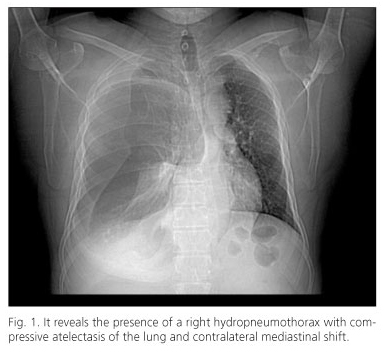Mi SciELO
Servicios Personalizados
Revista
Articulo
Indicadores
-
 Citado por SciELO
Citado por SciELO -
 Accesos
Accesos
Links relacionados
-
 Citado por Google
Citado por Google -
 Similares en
SciELO
Similares en
SciELO -
 Similares en Google
Similares en Google
Compartir
Revista Española de Enfermedades Digestivas
versión impresa ISSN 1130-0108
Rev. esp. enferm. dig. vol.104 no.10 Madrid oct./nov. 2012
https://dx.doi.org/10.4321/S1130-01082012001000007
PICTURES IN DIGESTIVE PATHOLOGY
Fundoplication intrathoracic migration associated with gastric organoaxial volvulus
Migración intratorácica de funduplicatura asociado a vólvulo gástrico organoaxial
María Dolores Casado-Maestre1, María Socas-Macías2, Salvador Morales-Conde2, Cristina Méndez-García2, Antonio Barranco-Moreno2, Jean Marie Cadet-Dussort2, Javier Padillo-Ruiz2 and María Eugenia Gómez-Rejano3
1Unit of Clinical Management and Digestive Surgery. Hospital Universitario Puerta del Mar. Cádiz, Spain.
2Unit of Innovation and Minimally Surgery. Hospitales Universitarios Virgen del Rocío. Sevilla, Spain.
3Translation and Interpreting Studies. Universidad Pablo Olavide. Sevilla, Spain
Case report
A 49-year-old man presented at the emergency department for severe epigastric pain and a 48-hour episode of vomiting with a greatly affected general state. This is a patient diagnosed with Behçet's disease and ankylosing spondylitis, operated for a hiatal hernia two months before his admission, where a laparoscopic Nissen fundoplication and pillars closure were performed. During the immediate postoperative period, he manifested a picture of vomiting and dysphagia after waking up from the anesthetic procedure. Both disappeared with corticosteroid administration.
At the admission to the hospital, the patient showed clear signs of difficulty breathing, paleness, sweating, tachypnea, and tachycardia. On examination, we found no breath sounds in the right hemithorax, and the abdominal exploration revealed signs of rigidity of abdominal wall. Chest X-ray (Fig. 1).
Our differential diagnosis stated hiatal hernia recurrence vs. secondary acute esophageal perforation for abdominal overpressure due to persistent nausea (Boerhaave syndrome). A thoraco-abdominal CT scan was requested (Fig. 2).
An urgent surgery was performed, where we found a complete transhiatal migration from stomach to chest and an associated organoaxial volvulus, as well as a partially disrupted fundoplication. Once the herniated viscera were reintroduced in the abdominal cavity, a proper vascularisation was showed. The fundoplication was rebuilt and the pillars were approached. An abdominal drainage was inserted and removed 4 days after the postoperative period.
Discussion
The Nissen fundoplication is considered as the "gold standard" procedure in patients which are affected by a gastroesophageal reflux disease resistant to conservative management. Thanks to it, efficient clinical and histological results with a low operative morbidity and mortality rates are achieved (1).
Long-term antireflux surgery re-operations are close to 3%, as published in the broadest series shown in the bibliography. Fundoplication intrathoracic migration which determines a persistent clinical outcome is the most frequent cause (27.9%) of re-operation in the late postoperative antireflux surgery. In descending order of frequency are described: disruption of the fundoplication (22.7%), telescoping (14.1%), paraesophageal hernia (6.1%), disruption of hiatus (5.3%), tight fundoplication (5.3%) and stenosis (1.9%) (2,3).
The need for urgent reoperation (excluding those cases of bleeding during the immediate postoperative period or injury to nearby organs) is anecdotal.
The differential diagnosis of this report, with cardinal symptoms of dyspnea, epigastric pain, tachypnea and tachycardia coming after a persistent vomiting episode, and associated to the figure of the chest X-ray (Fig. 1) may correspond to either Boerhaave syndrome as a problem related to the fundoplication previously performed. The patient did not show subcutaneous emphysema or pneumomediastinum, which are characteristic findings of transmural distal esophageal perforation. Finally, the CT scan revealed the presence of gastric herniation in the chest cavity.
In order to clarify the diagnosis, the upper gastrointestinal investigation can prove the leak and the anomalous position of abdominal viscera, but it does not provide information concerning the vascular supply, ischemic findings or the existence of collections. However, the computed tomography (CT) does provide crucial information, so that the need for intervention and the choice of approach can be determined (3).
With a view to avoiding this problem, we emphasize the importance of preventing nausea and vomiting in the immediate postoperative period of hiatal hernia repair, since it may condition the disruption of the fundoplication as well as the closing of the pillars in a way that they could cause hernia recurrence and the development of other complications.
References
1. Parrilla P, Martínez de Haro L, Ortiz A, Molina J. Enfermedad por reflujo gastroesoágico. En: Guía Clínica de la Asociación Española de Cirujanos. Cirugía Esofagogástrica; Madrid: Arán Ediciones; 2005. p. 203-25. [ Links ]
2. Hamdy E. Long term outcomes of laparoscopic antireflux surgery. Hepatogastroenterology 2011;58:56-63. [ Links ]
3. Furnée EJ, Draaisma WA, Broeders IA, Gooszen HG. Surgical reintervention after failed antireflux surgery: a systematic review of the literature. J Gastrointestinal Surg 2009;13:1539-49. [ Links ]











 texto en
texto en 




